Выборка записей по тегу "2017"
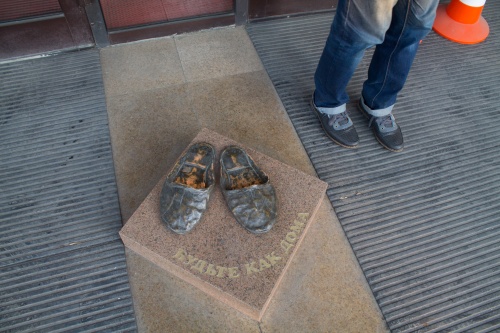
25. Памятник домашним тапочкам / Monument to house slippers
Этот оригинальный памятник за авторством известного томского скульптора Олега Кислицкого был установлен в 2006 году возле главного входа гостиницы "Томск". Он призван символизировать гостеприимство и уют. Свою идею Кислицкий предложил рассмотреть участникам проходившего в 2006 году в Томске саммита "Российской гостиничной ассоциации", которые, проникшись, даже устроили своеобразный аукцион для выбора места установки подобного символического памятника. В итоге, при непосредственном участии директора гостиницы "Томск" Михаила Кофмана, тапочки остались в Томске. Как утверждает сам автор, он долго размышлял над тем, какими именно должны быть входящие в композицию тапочки, и в итоге сделал их по слепку с собственного домашнего тапочка, посчитав, что именно такой подход наиболее полно передаёт домашнюю атмосферу.
This original monument authored by the famous Tomsk sculptor Oleg Kislitsky was installed in 2006 near the main entrance of the hotel "Tomsk". It is called to symbolize hospitality and coziness. Kislitsky suggested to consider his idea to the participants of the summit of the "Russian Hotel Association" held in Tomsk in 2006, who, being impressed, even arranged peculiar auction for choosing the place of installation of such a symbolic monument. As a result, with the direct participation of the director of the hotel "Tomsk" Mikhail Kofman, the slippers were left in Tomsk. According to the author himself, he pondered for a long time how exactly must looked like slippers included in the composition, and eventually made them on a cast from his own home slipper, believing that this is the approach that best conveys the home atmosphere.
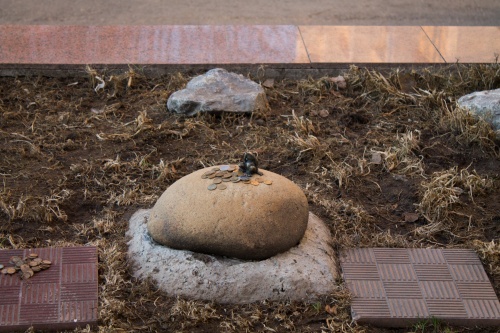
26. Памятник лягушке-путешественнице - самый маленький памятник в мире / Monument to the frog-traveller - smallest monument in the world
Рядом с гостиницей "Томск" установлен и ещё один необычный памятник. Это памятник лягушке-путешественнице, владеющий, пусть и судя по всему неофициально, титулом "самый маленький памятник в мире" (ранее пальма первенства принадлежала петербургскому Чижику-Пыжику). Памятник, автором которого опять же является Олег Кислицкий, был установлен 27 сентября 2013 года. Высота бронзовой фигурки - всего 44 миллиметра, но, судя по количеству оставляемых рядом монеток, крошка пользуется популярностью, которой могли бы позавидовать её гораздо большие собратья.
Next to the hotel "Tomsk" is installed and another unusual monument. This is a monument to the frog-traveler, which, though unofficially, owns the title of "the smallest monument in the world" (previously the palm of supremacy belonged to the St. Petersburg Chizhik-Pyzhik). The monument, authored by Oleg Kislitsky (again!), was installed on September 27, 2013. The height of the bronze figure is only 44 millimeters, but judging by the number of coins left beside frog, baby is so popular, that its much larger brethren could be envied it.
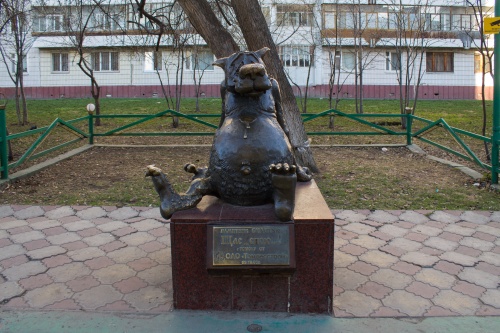
27. Памятник счастью / Monument to the happiness
Памятник счастью был установлен 5 октября 2005 года по инициативе ОАО "Томлесстрой" в качестве подарка городу в честь его 400-летия. Автором идеи называют пресс-секретаря компании Анатолия Захарова. Непосредственную работу выполняли скульптор Юлия Завьялова, литейщик Максим Петров и художник-консультант Леонтий Усов. Памятник, изображающий Волка из культового советского мультфильма "Жил-был пёс...", необычен ещё и тем, что его брюхо напичкано электроникой, и при нажатии расположенной на животе кнопки он голосом Джигарханяна произносит одну из восьми знаменитых мультцитат (например, ту самую "Щас спою..." или "Ты заходи, если что"). С прискорбием стоит отметить, что уже через месяц после установки памятника кто-то украл всю его "электронную начинку". Впрочем, благодаря усилиям местных властей, её быстро восстановили, а за памятником установили видеонаблюдение. Из-за этой характерной особенности памятника с ним связана малораспространённая байка: якобы через некоторое время после установки памятники вечерком к нему прислонился подвыпивший мужичок, а разговорчивый Волк внезапно попросил оставить ему покурить. Судя по всему, ноги этой байки растут из грандиозных (но нереализованных) планов сделать фразы Волка контекстно-интерактивными.
The monument to happiness was installed on October 5, 2005 on the initiative of OJSC "Tomlesstroy" as a gift to the town in honor of its 400th anniversary. The press secretary of company Anatoly Zakharov is called as the author of the idea. Direct work was done by sculptor Yulia Zavyalova, foundry Maxim Petrov and artist-consultant Leonty Usov. The monument depicting the Wolf from the cult Soviet cartoon "Once upon a time there was a dog ..." is unusual also because his belly is stuffed with electronics, and when the button on the stomach is pressed, he pronounces one of the eight famous citates from cartoon (for example, the same one "Right now I'll sing ..." or "You come in, in the case"). Sadly, it is need noting that one month after the installation of the monument, someone stole his entire "electronic stuffing". However, thanks to the efforts of local authorities, it was quickly restored, and video surveillance was installed behind the monument. With this characteristic feature of the monument is associated a little-spread fable: ostensibly some time after installation of the monument, in the evening, a drunk man leaned against him, and the talkative Wolf suddenly asked to leave him a cigarette. Apparently, the legs of this fable grow from grand (but unrealized) plans to make Wolf phrases contextually-interactive.
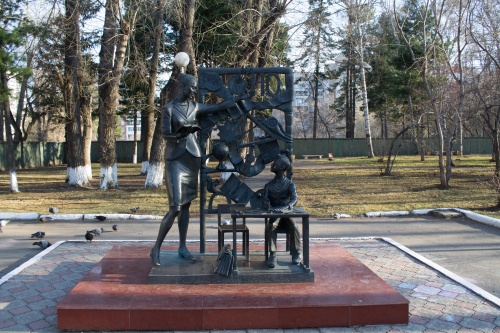
28. "Учительница первая моя..." / "My first teacher..."
Скульптурная композиция "Учительница первая моя" была установлена в Учительском сквере, рядом с главным корпусом Томского государственного педагогического университета, 5 октября 2010 года, который был объявлен в России годом учителя. Автор композиции - известный московский художник Олег Киевский, чей проект вышел победителем в борьбе с проектами 11 других скульпторов из разных городов России. Саму скульптуру отливали в Смоленске, причём, финансирование было частично обеспечено добровольными взносами горожан. Первоначально областная администрация планировала разместить композицию в Университетской роще ТГУ, однако по просьбам педагогической общественности города местом установки в итоге был выбран именно Учительский сквер.
The sculptural composition "My first teacher" was installed in the Teacher's square, next to the main building of Tomsk State Pedagogical University, on October 5, 2010, which was declared in Russia as the year of the teacher. The author of the composition is the famous Moscow artist Oleg Kievsky, whose project became the winner in the struggle against the projects of 11 other sculptors from different cities of Russia. The sculpture itself was cast in Smolensk, and the funding was partly provided by voluntary contributions from the townspeople. Initially, the regional administration planned to place the composition in the University Grove of TSU, but at the request of the pedagogical community of the town, in the end, it was the Teacher's square that was chosen as the place of installation.
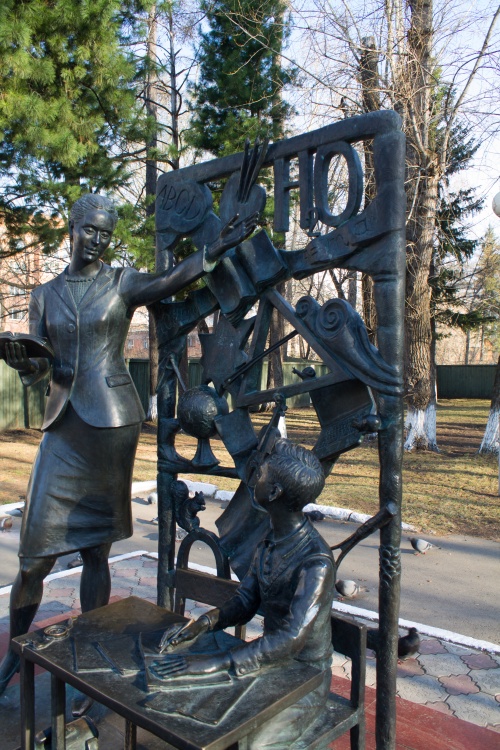
29. Учат в школе, учат в школе, учат в школе... / Studying at school, studying at school, studying at school...
Нельзя не отметить впечатляющую детализацию томского памятника учительнице и обилие различных вещей на своеобразной "доске" на заднем плане. Кажется, что здесь найдётся ассоциация для всего, что только можно встретить в школе: тут и химическая формула воды, и буквы латинского алфавита, и фамилия Пушкина, и разная живность, и глобус, и палитра с кисточками, и скрипка со смычком, и спрятавшаяся за спиной ученика теннисная ракетка, и даже ноутбук!
It is impossible not to mention the impressive detailing of the Tomsk monument to the teacher and the abundance of various things on a kind of "schoolboard" in the background. It seems that there is an association for everything that can be studying in school: here are the chemical formula of water, the letters of the Latin alphabet, the surname of Pushkin, different small animals, the globe, the palette with tassels, the violin with the bow, a tennis racket, hiding behind the pupil's back, and even a laptop!
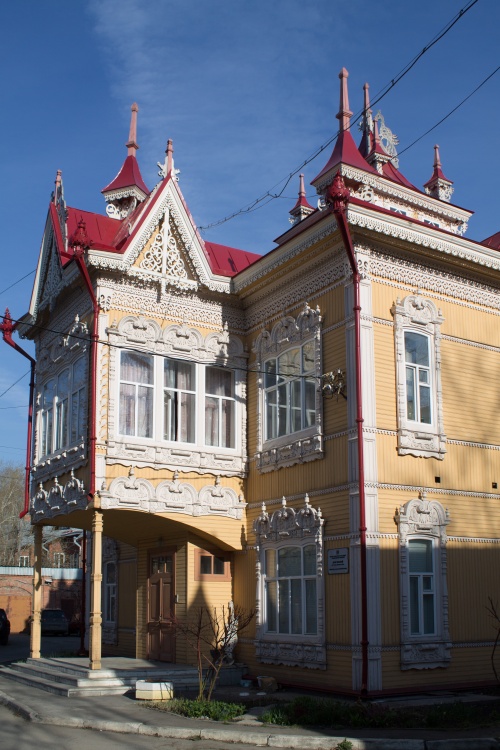
30. Флигель купеческой усадьбы Л. Д. Желябо / The outbuilding of the merchant's estate of L. D. Zhelyabo
Дом по адресу "улица Красноармейская, 67/1" - это едва ли не самый яркий памятник деревянного зодчества в Томске. Он был построен в 1903 году во внутреннем дворе усадьбы купца Леонтия Желябо по проекту главного архитектора Томска Петра Федоровского (который сам по себе - личность примечательная, закончил Петербургскую академию художеств, обучался у известного русского художника Александра Бенуа). Постановлением Совета Министров РСФСР №624 от 4 декабря 1974 года дом был включен в список архитектурных памятников федерального значения.
The house at "Krasnoarmeyskaya (Red Army) street, 67/1" maybe is the most outstanding monument of wooden architecture in Tomsk. It was built in 1903 in the courtyard of the estate of merchant Leonty Zhelyabo by the project of the chief architect of Tomsk, Petr (Peter) Fedorovsky (who itself is a remarkable person, graduated from the St. Petersburg Academy of Arts, studied with the famous Russian artist Alexander Benois). By Decree of the Council of Ministers of the RUFSR No. 624 of December 4, 1974 the house was included in the list of architectural monuments of federal significance.

31. Дом с жар-птицами / House with fire birds
Помимо этого дома, известного в Томске и как "дом с жар-птицами", в состав ансамбля усадьбы Леонтия Желябо входило ещё три дома. И у каждого из этих домов - сложная судьба. Из четырёх строений лишь тот самый "дом с жар-птицами" сохранил свою аутентичность до наших дней, ещё два здания усадьбы представляют собой реконструкции на месте старых зданий, осуществлённые в 80-е годы по программе "Старый Томск", но больше всего не повезло зданию по адресу "улица Красноармейская, 65/1" - сначала пришедший в полную негодность дом был расселён, затем земельный участок под ним был продан на аукционе, а в итоге на месте деревянного домика был выстроен бетонный новодел, обшитый тесом. Городская администрация планировала через суд добиться сноса новостройки и восстановления архитектурного памятника, однако, судя по тому, что дом стоит, как стоял, ничего из этой затеи не вышло. Под угрозой было и существование последнего оригинального здания в ансамбле усадьбы. К 2008 году "дом с жар-птицами" очень серьёзно обветшал после последнего ремонта. Особенно сложная ситуация сложилась с крышей здания, пришедшей практически в полную негодность. Спасли дом лишь старательность и настойчивость его жильцов, внимание общественности и СМИ, а также отвалившийся от потолка во время очередного дождя и чудом никого не прибивший кусок штукатурки. В итоге всё-таки было принято решение о ремонте и реставрации дома, проведённых в два этапа.
In addition to this house, known in Tomsk as a "house with fire birds," the ensemble of the estate of Leonty Zhelyabo included three more houses. And each of these houses had a difficult destiny. Of the four buildings, only that "house with fire birds" has retained its authenticity to our days, two more buildings of the estate are reconstructions on the site of old buildings that were carried out in the 80s under the program "Old Tomsk", but the most sad fate befell to the building at "Krasnoarmeyskaya (Red Army) Street, 65/1" - first of all, the house, that became completely unfitness, was settled out, then the land plot under it was sold at auction, and in the end, a concrete replica was built on the site of the wooden house. The town administration planned through the court to demolish the new building and restore the architectural monument, however, judging by the fact that the house stands as it stood earlier, nothing came of this venture. The existence of the last original building in the ensemble of the estate was also under threat. By 2008, the "house with fire birds" had decayed very seriously after the last repair. Particularly difficult situation arose with the roof of the building, which came almost completely out of order. The house was saved only by the diligence and perseverance of its residents, the attention of the public and the media, and also by a piece of plaster, which fell off the ceiling during the rain and miraculously slamed nobody. As a result, it was finally did a decision about repair and restoration of the house, that were conducted in two stages.
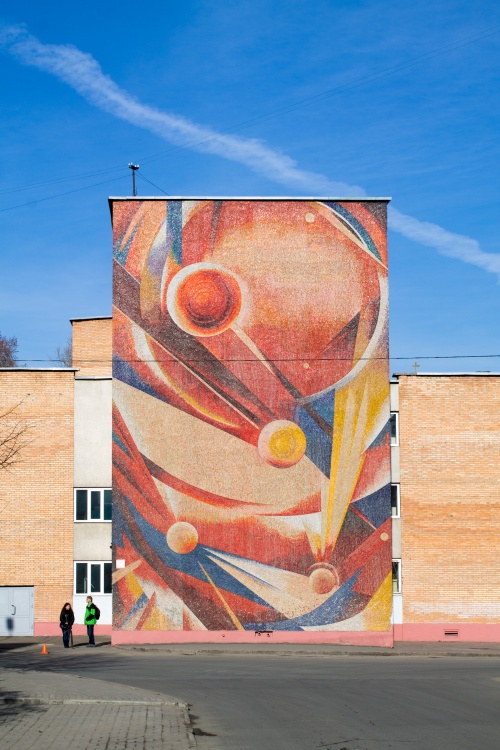
32. Монументальная мозаика "Парад планет" / Monumental mosaic "The Parade of the Planets"
Новое здание томского Дворца пионеров было торжественно открыто 8 февраля 1980 года. А в 1987 году на одной из его стен появилость эпичное мозаичное полотно "Парад планет" за авторством Николая Беглюка. Как вспоминает сам автор, наиболее сложным во всей работе над мозаикой было найти общий язык с заказчиком. По его словам, до него это не удалось как минимум трём другим художникам. Облком КПСС настаивал на традиционной пионерской символике с горнами и знамёнами, но Беглюку удалось настоять на своей идее о пионерах, как первопроходцах, метафорично выраженной через образ космоса. Это позволило создать работу, не привязанную к символам эпохи, что делает её ещё более ценной. Сами работы по укладке смальты заняли всего лишь около четырёх месяцев. Позднее, уже в 2000-х годах была проведена незначительная реставрация мозаики - слишком большое число элементов на высоте человеческого роста было растащено на сувениры.
The new building of the Tomsk Palace of Pioneers was solemnly opened on February 8, 1980. And in 1987, on one of its walls appeared an epic mosaic painting "The Parade of the Planets" for the authorship of Nikolay Beglyuk. As the author himself recalls, the most difficult part of the whole work on the mosaic was to find a common language with the customer. According to him, at least three other artists hadn't be able to do it before him. The regional committee of CPSU wanted traditional pioneer symbols with bugles and banners, but Beglyuk managed to insist on his idea of pioneers as first researchers, metaphorically expressed through the image of the cosmos. This allowed him to create a work that is not tied to the symbols of the era, which makes it even more valuable. The works on laying smalt took only about four months. Later, already in the 2000s, an insignificant restoration of the mosaic was carried out - too many elements at the height of human height were chipped for souvenirs.
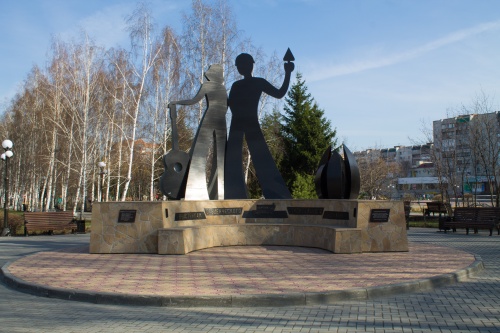
33. Памятник студенческим стройотрядам / Monument to student construction squads
В 2013 году, в 50-летнюю годовщину томских студенческих стройотрядов, был серьёзно реконструирован сквер рядом с Дворцом спорта. Венцом реконструкции стало открытие 7 сентября того же года памятника участникам стройотрядовского движения, созданного по эскизу скульптора Антона Гнедых. В основание памятника также была заложена "капсула времени" с посланием к столетию движения.
In 2013, on the 50th anniversary of the Tomsk student construction squads, the square near Sports Palace was seriously reconstructed. The crowning of the reconstruction was the opening on September 7 of the same year of a monument to the members of the construction squad movement, created according to the sketch of the sculptor Anton Gnedykh. At the base of the monument was also laid the "time capsule" with a message to the centenary of the movement.
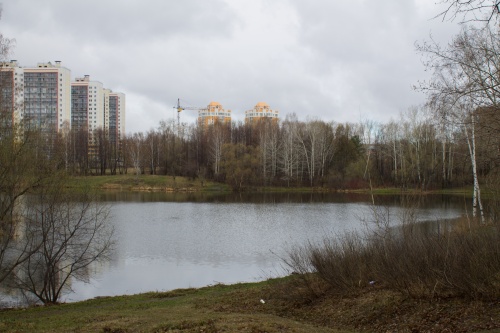
34. Пруд на территории экспериментального хозяйства Ботанического сада ТГУ / Pond on the territory of experimental farm of the Botanical Garden of TSU
Практически все томичи и многие гости города знакомы с территорией Сибирского ботанического сада ТГУ рядом с главным корпусом университета. Однако, для многих оказывается сюрпризом существование "южной площадки" сада - его экспериментального хозяйства. Между тем, эта весьма приличных размеров территория в районе улиц Нефтяной и Мокрушина была выделена саду ещё в 1930-х годах. В отличие от университетской площадки социальным благоустройством южной особо не занимались, что однако не мешает ей быть замечательным местом для прогулок. Своеобразным центром притяжения на территории сада является Ботаническое озеро, в котором обитают утки и вокруг которого высажено множество деревьев самых различных пород. Именно в районе озера запланировано начать в 2017 году создание рекреационной зоны.
Virtually all Tomsk townspeople and many guests of the town are familiar with the territory of the Siberian Botanical Garden of TSU near the main building of the university. However, for many it is a surprise that there is a "southern area" of the garden - its experimental farm. Meanwhile, this very decent size territory in the area of the Neftyanaya (Oil) Street and Mokrushin's Street was allocated to the garden yet in the 1930s. Unlike the university area, the social improvement of the southern area virtually didn't doing, but, however, it doesn't prevent this territory from being a wonderful place for walking. A peculiar center of attention in the garden is the Botanical Lake, in which ducks live and around which a lot of trees of various breeds are planted. In the area of the lake have planned to begin in 2017 the creation of a recreational zone.
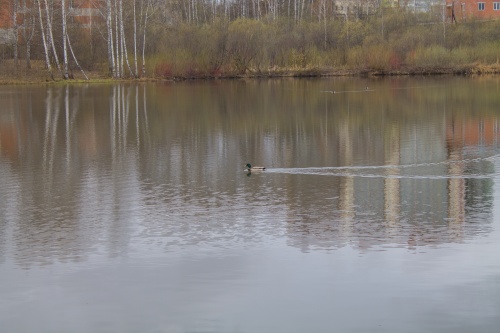
35. Утка в Ботаническом озере / Duck in the Botanical Lake
Можно сказать, что утки, обитающие в Ботаническом озере на территории экспериментального хозяйства Сибирского ботанического сада ТГУ, - всеобщие любимицы, которых наверняка подкармливают многие из регулярных посетителей "южной площадки" ботанического сада ТГУ. Помимо уток на территории сада немало и других птиц, для которых по деревьям развешаны кормушки. Кроме того, говорят, здесь можно встретить очаровательных белочек. Однако, в бочке мёда не обходится и без ложки дёгтя - часть территории сада недалеко от озера несмотря на все запреты облюбована для прогулок хозяевами разномастных собак.
It can be said that the ducks that live in the Botanical Lake on the territory of the experimental farm of the Siberian Botanical Garden of the TSU are people's favorites, and many of the regular visitors of the "southern area" of the Botanical Garden of the TSU surely feed them up. In addition to ducks in the garden there are many other birds, for which the troughs are hung on the trees. In addition, it rumors, here you can meet charming squirrels. However, ointment cannot be without a fly in it - part of the garden near the lake, despite all the prohibitions, was chosen for walks by the owners of different dogs.
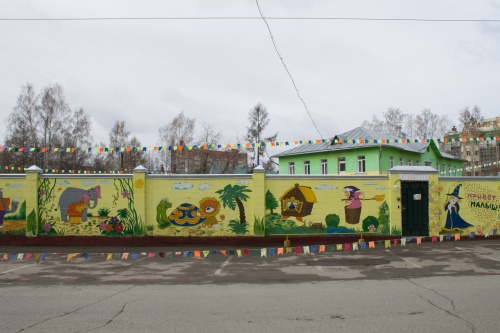
36. Разрисованный забор возле Центра раннего развития "Созвездие" / Fence with paintings near the Center for Early Development "Constellation"
При обустройстве летом 2016 года капитального забора возле Центра раннего развития "Созвездие" и детского сада №40 его уличную сторону разрисовали героями известных отечественных сказок и мультфильмов. Само по себе возведение такого забора связано с ужасным резонансным событием летом 2014 года, когда трёхлетняя девочка была похищена прямо с территории детского сада №46 и впоследствии найдена убитой. Именно после того события городская администрация инициировала обустройство детских дошкольных учреждений средствами видеонаблюдения, а также обустройство новых ограждений.
With the arrangement in summer 2016 of a concrete fence near the Center for Early Development "Constellation" and kindergarten №40, its street side was painted with heroes of famous Russian fairytales and cartoons. The very construction of such a fence is associated with a terrible resonance event in the summer of 2014, when a three-year-old girl was kidnapped directly from the territory of kindergarten №46 and subsequently was found dead. It was after that incident that the town administration initiated the arrangement of children's preschool institutions with video surveillance equipment, as well as the arrangement of new fences.
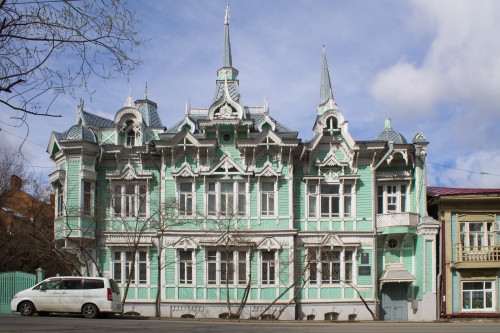
37. Особняк архитектора С. В. Хомича / The mansion of architect S. V. Khomich
Здание, построенное для себя и своей семьи в 1904 году архитектором С. В. Хомичем - ещё один томский архитектурный памятник федерального значения. Архитектор с семьёй проживал в нём до 1914 года, параллельно сдавая часть помещений под частные квартиры. В дальнейшем здание частенько изменяло свой профиль: в 1924 году здесь располагался Эксплуатационный техникум Томской железной дороги, затем здание служило общежитием для студентов ТГУ, во второй половине 30-х годов здесь квартировали видные медицинские работники, долгое время здание занимали дом ребёнка №3, а потом Областная детская больница. В 90-х годах здание передали Лицензионной палате Томской области с условием проведения реставрационных работ. Нынче, рассказывая об этом доме, томичи частенько вспоминают одну из городских легенд: якобы архитектурные кружева томских деревянных домов и покрашенные в зелёный цвет крыши и ограды послужили одним из источников вдохновения для адаптации Александром Волковым сказок Лаймэна Фрэнка Баума в форме "Волшебника изумрудного города".
The house, built for himself and his family in 1904 by architect S. V. Khomich, is another Tomsk architectural monument of federal significance. The architect with his family lived in it until 1914, while renting out part of the premises for private apartments. Further the building was changing its profile quite often: in 1924 it was housing the Exploitation college of Tomsk railroad, then the building was serving as a hostel for TSU students. In the second half of the 30s, prominent medical workers was lodging here, for a long time the building was occupied by the child's house №3, and Then Regional Children's Infirmary. In the 90s the building was handed over to the Licensing Chamber of the Tomsk Region with the condition of carrying out restoration work. Today, telling about this house, Tomsk townpeople often recalled one of the town's legends: ostensibly architectural laces of Tomsk wooden houses and painted in green roofs and fences had served as one of the sources of inspiration for Alexander Volkov's adaptation of fairy tales of Laiman Frank Baum in the form of "The Wizard of the Emerald City."
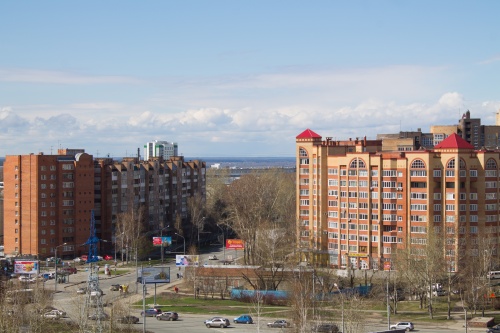
38. Томск в начале мая / Tomsk in early May
Хотя здание нового корпуса Томского университета систем управления и радиоэлектроники и не является локальной архитектурной доминантой, но из окон его верхних этажей можно бросить неплохой взгляд на центр города. Конечно, обзору серьёзно мешают многоэтажки в районе Транспортной площади, но, тем не менее, за ними можно разглядеть кварталы пятиэтажных хрущёвок, а ближе к Томи - и невысокие деревянные домики старого города. На дворе - самое начало мая, поэтому урбанистические черты города ещё не скрыты покровом древесной листвы.
Although the new building of the Tomsk University of Control Systems and Radioelectronics is not a local architectural dominant, but from the windows of its upper floors you can throw a good look at the town center. Of course, high-rise buildings in the area of Transport Square is seriously interfering with visibility, but nevertheless, behind them you can see the quarters of five-stories Khrushchev-style buildings, and closer to Tom - the low wooden houses of the old town. In the picture is the very beginning of May, so the urban features are not hidden by the cover of foliage.


